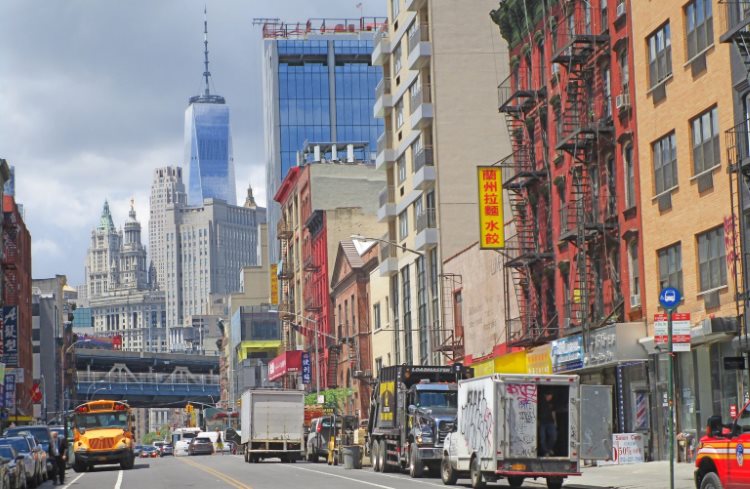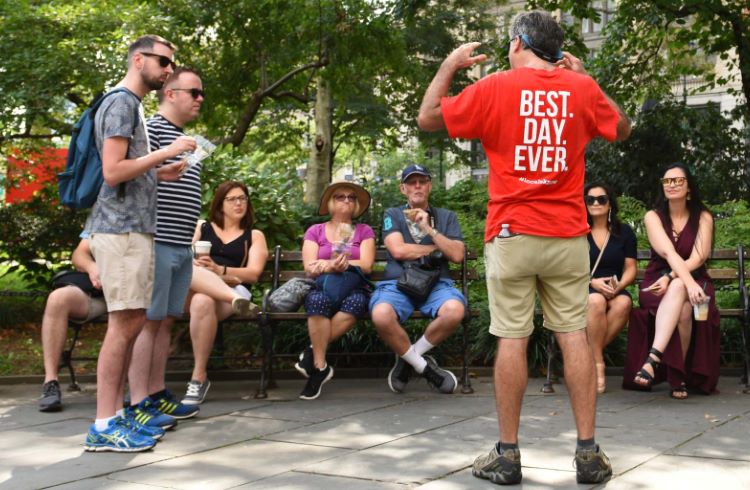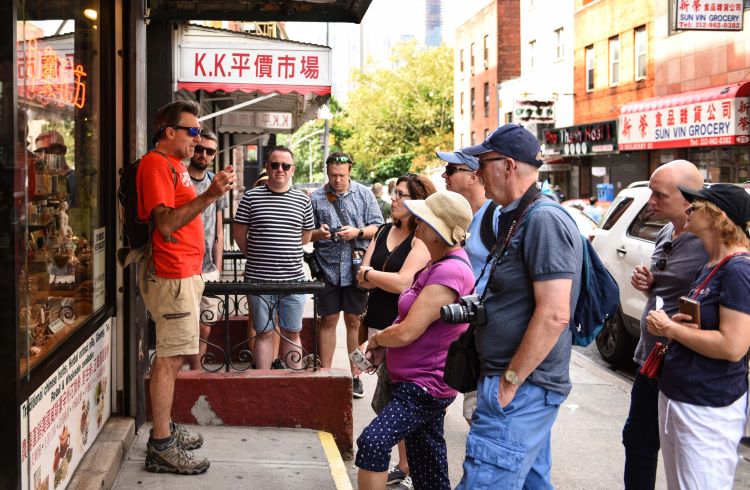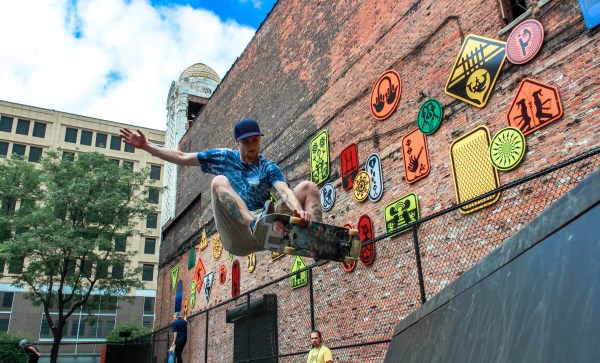Exploring New York City on Foot During COVID-19
Even when the rest of Manhattan is crowded with visitors, the Lower East Side remains off the beaten path and is perfect for a history-steeped, socially-distanced walking tour.
 Photo © Bruce Northam
Photo © Bruce Northam
Manhattan’s Lower East side is the North Star of New York City’s gritty soul – and remains so despite the Big Apple becoming a deserted COVID-19 orchard. While this pandemic has reduced most of Manhattan’s tourist attractions down to nearly nil, it has gifted the Lower East Side more of what it does best: being on the fringe.
This neighborhood, once the bustling, jam-packed new frontier of American immigration, slowly transitioned over the last decade from a dodgy place most people avoided into Manhattan’s newly hip, off-the-beaten-path quarter.
Although geographically it makes sense to call it the Lower East Side (aka LES), its name actually derives from the parts of the neighborhood averaging only 20ft (6m) above sea level, as compared to Manhattan’s Upper East Side, rising as high as 175ft (53m) above sea level. In real estate terms, you might call the LES bargain swampland, a label that was certainly evinced when Superstorm Sandy drowned the neighborhood in 2012.
- A new kind of New York walking tour
- The many phases of the Lower East Side
- Some highlights from a stroll through the Lower East Side
A new kind of New York walking tour
After a raucous suburban Long Island childhood, I’ve been living in Manhattan’s LES since 1985. I began giving walking tours around my neighborhood a few years ago, so I know it well. In terms of people jams, my tour is a literal walk in the park, where social distancing is a cinch. I’ve made a few other concessions to the pandemic – masks are required, for example, and we no longer go inside certain businesses.
Because of cramped quarters, bars have doubled as New Yorker’s living rooms for centuries. That’s no longer the case. But, one upside to the pandemic’s impact on NYC has been the resurrection of locals meeting for outdoor happy hours. As New Yorkers mingle throughout Gotham’s streets and parks, we’ve all rediscovered that we can survive socially without bars. The city once known as the place to see Broadway plays, scale skyscrapers, and dine to your heart’s content now features outdoor venues offering North America’s best people watching. The underdog Lower East Side has been ready for this trend since the Dutch began running New York in 1624.

The many phases of the Lower East Side
In 1910, the LES was considered the world’s most notorious slum when it crammed 2.3 million residents within 535 acres; that’s 400,000 people per mi2 (154,000 per km2). Today, the entire population of Manhattan island is 1.6 million. What makes these statistics even more flabbergasting is that, in 1910, the LES was mostly four-story tenement buildings, compared to modern Manhattan’s skyline boasting mostly skyscrapers.
The LES has hosted many immigration waves, with the largest clans arriving in this order: Dutch, English, Irish, German, Italian, Jewish, Chinese, Puerto Rican. The ultimate quest of those groups soon became moving out of the LES to greener parts of the city or the suburbs. A ghost town until 10 years ago, this now trendy neighborhood was resurrected once people realized they could live as affordably here as in the outer boroughs and reap all the cultural benefits of Manhattan without a long commute (if any).
COVID-19 has upended our former way of living, globally. But, pandemic or not, here’s some of what you can safely encounter in Manhattan’s LES on foot.

Some highlights from a stroll through the Lower East Side
- The Williamsburg Bridge roars into the heart of the LES via Brooklyn. Completed in 1903, it was originally used by pedestrians, trolleys, and railways. Today, it carries eight lanes of roadway, two subway tracks, and a spectacular pedestrian walkway. There is talk of renaming it “The Rollins Bridge” for legendary American jazz tenor saxophonist Sonny Rollins, who lived near the bridge and frequently practiced on it when his neighbors complained about him doing so indoors. These outdoor practice sessions coincided with a career slump that ended in 1962, when the songs he wrote on the bridge landed on what became his most successful album, The Bridge.
- During the American Revolutionary War, George Washington placed an army at Corlears Hook (now Corlears Hook Park) and chose a nearby Dutch-built mansion as his headquarters. In 1839, the street flanking what is now the park had 87 brothels. If you were seeking a prostitute back then, it meant going to “the hook,” which soon coined the term “hooker”. Today, the park features beautiful gardens, seasonal yoga, and a dog run where labradoodles frolic with pit bulls.
- The LES is an architectural candy store. Here, classic gems meld with some of the city’s oldest housing projects (such as the Vladeck Houses, built in 1940). Luckily, there are many grand architectural landmarks of centuries past that survived the urban-renewal bulldozer, including Old Gouverneur Hospital. Built in 1901 in Renaissance style, it was the first public US hospital to open a tuberculosis clinic as well as the first to employ a woman ambulance surgeon. Today, renovated into 123 apartments, it houses homeless and special needs adults.
- St. Augustine’s Episcopal Church was built in 1828, the year after slavery was legally abolished in New York State. However, the church still has the remnants of a slave gallery, two cramped rooms with mini windows hidden upstairs in the rear of the church. Edgar Allan Poe frequented the building seeking peace for his troubled mind. Later, infamous politician “Boss” Tweed, while a fugitive from justice, attended his mother’s funeral here, hiding from the authorities in the slave gallery.
- The city’s most famous Jewish food landmark is Katz’s Delicatessen, on East Houston Street, but you’ll likely have to wait in a long line for that experience. For a sample of Jewish culture without the tourists, we stop at two ultra-Kosher businesses that are neighbors on Grand Street. One deli-style market features Kosher pizza and sushi. Next door, a classic bakery has a vintage bread cutter that’s missing one blade, so each sliced loaf comes with one double-wide slice.
- We go into the authentic version of eastern Chinatown, which is starkly different than the tourist-friendly, Disney version of Chinatown west of the Bowery – even most New Yorkers don’t know about it. For now, I’m giving guests the option of not entering its most hardcore wet markets. As compared to how most of America operates, New York’s Chinatown has its own culinary ecosystem. Whereas most of the food Americans eat is transported by huge trucking companies like Sysco, the meat, fish, and vegetables sold here are sourced from Chinese-owned businesses along the east coast and stored outside the city, mostly in New Jersey. From New Jersey, items are delivered on-demand by vans, making them fresher and cheaper than the competition.
While in New York City – a cross-cultural melting pot within a melting pot – don't be afraid to roam out of bounds. On our walkabout, you’ll develop a heightened respect not only for your food's journey, but the journey of this nation. Seize the moments and discover insights you can’t find online.
Related articles
Simple and flexible travel insurance
You can buy at home or while traveling, and claim online from anywhere in the world. With 150+ adventure activities covered and 24/7 emergency assistance.
Get a quote

No Comments